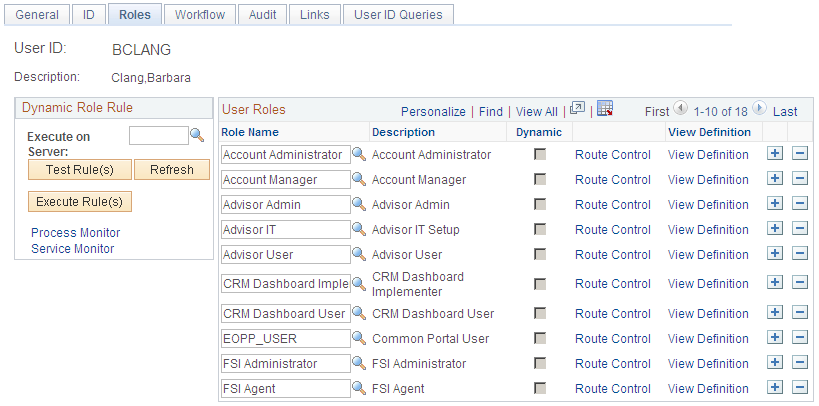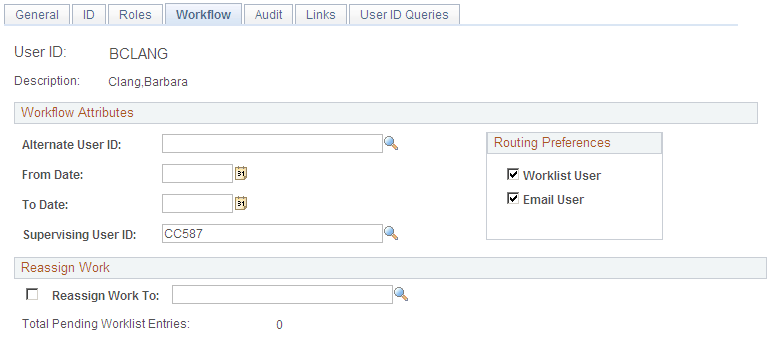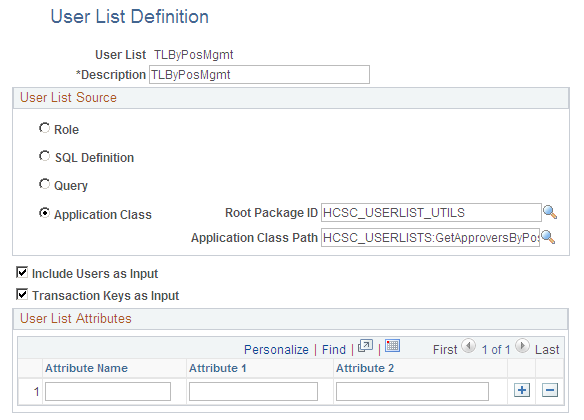Defining Users for Approval Framework
This section discusses how to define users for approval framework.
|
Page Name |
Definition Name |
Usage |
|---|---|---|
|
USER_ROLES |
Attach workflow roles to users. |
|
|
USER_WORKFLOW |
Define workflow for user profiles. |
|
|
EOAW_USER_LIST |
Define user lists. |
Use the User Profiles - Roles page (USER_ROLES) to attach workflow roles to users.
Navigation:
This example illustrates the fields and controls on the User Profiles - Roles page. You can find definitions for the fields and controls later on this page.

Use this page to attach workflow roles to users. A role is a class of users who perform the same type of work, such as clerks, buyers, or managers. A role describes how people fit into workflow.
Role user IDs determine how to route worklist items to users and how to track the roles that users play in the workflow.
Field or Control |
Description |
|---|---|
Role Name |
Select a role to assign to this user. Role users are the people who participate in automated business processes. |
Dynamic |
Appears if the definition of this role is dynamic. This value is driven by PeopleSoft PeopleCode. Dynamic users can obtain membership in a role programmatically. You can run a batch process that executes predefined role rules and assigns roles to user profiles according to these rules. This approach is called dynamic membership, and users who become role users of a particular role programmatically are dynamic role users. Static role users, on the other hand, obtain their membership through an administrator adding a role to their user profile manually. |
Route Control |
Select to access the User Route Control Profiles page, where you can select a route control profile for the workflow. The PeopleSoft Workflow Administrator enables you to define route controls. For example, suppose you want to route requisitions to different buyers, depending on which vendor supplies the ordered items, which business unit is requesting the items, and which department needs the items. You can define a route control for each factor—vendor ID, business unit, and department—and specify a range of values for each buyer. Note: Not used with eProcurement Approval Framework. |
View Definition |
Select to access the Roles - General page, where you can change the role name definition. You can also view the user ID of the role member to ensure that you selected the appropriate definition for inclusion in the role. |
Use the User Profiles - Workflow page (USER_WORKFLOW) to define workflow for user profiles.
Navigation:
This example illustrates the fields and controls on the User Profiles - Workflow page. You can find definitions for the fields and controls later on this page.

Use this page to define alternate users who are part of the workflow process. You can define alternate users to handle approvals during the absence of the primary approver and supervisor.
Field or Control |
Description |
|---|---|
Alternate User ID |
Select a user to receive worklist items when this user ID is temporarily unavailable. In situations where the current role user is unavailable, the system automatically forwards the current role user's new work items to the specified alternate role user. The system doesn’t reassign items already in the user’s worklist. Note: For workflows that are built using the Approval Framework, if the current role user is unavailable for assignment, the system checks for a alternate user recursively until it either creates a cycle or finds a valid substitute. In other words, the system sends routings down multiple levels of alternate user IDs if necessary. For example, suppose that user A specifies user B as his alternate user, and user B specifies user C as his alternate user. If both user A and user B are out of the office the same time, the system sends workflow routings originally intended for user A to user C. |
From Date and To Date |
Enter a date range when the current user ID is not going to be available. The system uses these values to forward routings to the alternate user. |
Supervising User ID |
Select the user ID of this user’s supervisor. The system uses this value when forwarding information to the user’s supervisor and uses the PERSONAL_DATA record to determine the supervisor. Note: If you’re using PeopleSoft Human Capital Management (PeopleSoft HCM) applications, this field shouldn’t appear. If it does, you must set your workflow system defaults. |
Worklist User |
Select to indicate that this role user can receive approval routings. Clear the check box if the user is not a PeopleSoft user. You can select Worklist User, Email User, or both. |
Email User |
Select to specify that this role user can receive email. Clear the check box if email is not available. |
Reassign Work To |
This option is not used in Approval Framework. It will reassign the worklist, but not the underlying data in Approval Framework. |
Use the User List Definition page (EOAW_USER_LIST) to define user lists.
Navigation:
This example illustrates the fields and controls on the User List Definition page. You can find definitions for the fields and controls later on this page.

Use this page to define user sources for use with steps in the approval process. The PeopleSoft product delivers a set of default user list roles corresponding to the roles within an organization.
When you select a user list source type, you must also select a corresponding value. You can add a new user list or change a current list.
Note: You can only select one user list source for a user list.
Note: The SQL Definition, Query, and Application Class user list sources are dynamic, and can use input values to help identify users.
Field or Control |
Description |
|---|---|
Role |
Select to use a role as the source for this user list. A role is a list of users who perform the same type of work, such as buyers or managers. Each role has a set of parameters that determine the limits of the role in the organization and in the workflow process. |
SQL Definition (structured query language definition) |
Select to use an SQL definition as the source for this user list. The SQL must return OPRID field. |
Query |
Select to use a query as the source for this user list. When a source is defined as a query, the system determines who should receive a work item based on the field values on the page that triggers the routing. |
Application Class |
Select to use an application class as the source for this user list. When you select an application class, the system passes the originator of the transaction and then determines the approver for that originator. For subsequent approval steps, the system passes the approver from the previous step. |
Include Users as Input |
Select to indicate that the system uses the originator of a transaction as the first step in each path. For subsequent steps in each path, the system uses the approver from the previous step. This field is not available when the User List Source is User List. |
Transaction Keys as Input |
Select to have the system base the approval routing on transaction keys. Transaction keys are key fields in a database table. System actions depend on the approval level at which a user list is being used. If the approval is at the header level, the system uses transaction record keys from the header record. This field is not available when the User List Source is User List. |
User List Attributes |
This section is only available when the User List Source is Application Class. Note: UserList Attributes are used for application class User Lists and Route Control is used for role based user lists. |
Route Attributes
If User List Source is Role, the Route Attributes section is displayed. This option enables the Route Control filters.
Field or Control |
Description |
|---|---|
Route Control Profile |
Select the route control profile to use. |
Record Name |
Record the user passes in that stores the values used in the route control. Note: Route control checks against fields, Approval Framework needs to know which record contains the field. |
Route Control Type |
Route control attribute. Note: Route control attribute is defined on the User Profile Roles page in the route control link. |
Field Name |
Field on the record mapped to the attribute. |